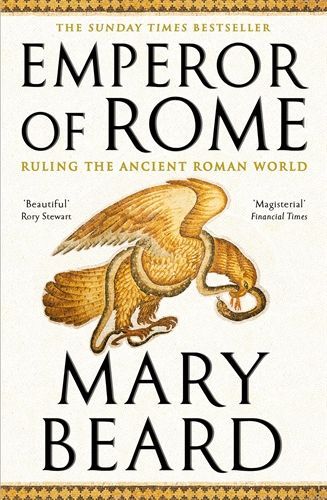Emperor of Rome
By Mary Beard
Published by: Profile Books (Allen and Unwin)
ISBN 9781846683787
When I heard Professor Emeritus Mary Beard speaking about Roman History on a BBC Program, she made the subject sound very interesting which inspired me to read her latest book. The way in which she explained and talked about the Romans on this program made it all the more enjoyable to listen to. Her similar radio style shines through this book. It is really is a most enjoyable and at times humorous book to read.
Although there are many words and names referred to in Latin throughout the book as one would expect, the way in which Beard explains them, makes perfect sense. If you have an ear for, or in this instance an eye for languages as I do, it is easy to see how many of our words stem from the Latin spoken at the time. As an example the word, Emperor comes from imperatur, prince is from princeps and so on.
The reader gains a good insight into the lives of the many Emperors, many have heard or read about the well known ones such as Caesar, Tiberius, Augustus, Nero, Caligula, Hadrian and others, but to readers who have not read or studied this period in history there are many others who had extraordinary lives.
These insights into their lives is fascinating and at times quite gruesome. We are not talking about the lives of the gladiators and the often horrific things that happened in the arena at the Colosseum that made me wince at the abject cruelty such as killing one hundred bears for sport, but also their bizarre dinners they hosted.
For example a young teenage Emperor, Elagabalus, who had some very peculiar ideas of food served to guests and they never new if they would survive, It was a risk one had to take if invited and an acceptance was not necessarily optional. For some guests of the lower orders they may not have be served any food, rather replicas in glass and had to watch as others ate the real food, drooling at the thought of what they were missing. One of the more strange things was spreading a living person with mustard and serving him up o a platter for the table. Another was providing whoopy cushions for his guests to sit on which deflated a the evening wore on.
Delving into their lives at times was interesting especially on several occasions when the author mentions a situation, which could be hearsay, perhaps it was truth or myth. We do not know because no actual records exist. Educated guesses? Much like the time when Nero’s friend was drowned or was he pushed?
Each chapter is divided into sub-sections as it focuses on various aspects of their lives such as the Emperor’s job description, the power sharing and the origin of empire, aspects of their clothing, what they meant and what was required wearing for different ocassions, what they did during their working day, succession and the many adoptions that took place for a good succession.
It was seen as better to adopt a son to succeed an Emperor even if they had both parents living as opposed to relying on what their wives could produce as off spring. Imagine the considerable jealousy in the families if someone else’s son was chosen over their own son, especially the highly competitive mothers, yet it seems it was commonplace.
We look at how some of the conflicts such as nineteen year old Octavian’s which were bordering on illegal, shockingly sadistic and ruthless. Plus the number of assassinations through either eating poisoned food. The poison administered by ambitious mothers, wives and others to ensure sucession or being pushed over the edge into a river and by other means is quite astounding.
Even more so are the forced suicides. Reading about some of the cruelest Emperors you can understand why they were forced to suicide.
Going further into the heart of the huge Roman Empire stretching from Dacia (Romania) to Spain and Britain into Africa, the section on power dining such as the Black Dinner were everything was painted black, even the slaves who served is quite intriguing reading. Or awaking to find live tame tigers and leopards roaming amongst the sleeping guests.
Reading about the palaces, their origins and how they were designed, the rooms such as no bedrooms, rather private multi-purpose rooms for personal and business use, no beds, rather couches, their communal lavatories with some seating forty people seems rather mind boggling.
The book continues with the gentler side or is it, with their wives and mistresses? Again, quite intriging to say the least. It is curious to read about the slaves and freed slaves who continued to work alongside each other. As is stated some freed slaves preferred to stay working as it was regular work and others because it could be safer than taking their chances outside. And then there is the buying and gifting of people.
The war in Alexandria, Egypt with the Jews is mentioned and the ongoing disputes and battles including the attempts to end the conflict, but does not go into the greater more disturbing details. While on this point it was interesting to note that the Colosseum was built with the spoils gained from these conflicts,
The Emporer’s names, the shortened versions and their full names of the better known ones will surprise you, on had twenty.
This easily read book is not your usual chronological account of the Roman Empire,. Mary Beard takes a different and far more interesting look at what actually happened from remaining records. There are many whether that be on small pieces of papyrus or stamped components on buildings.
The substantial further reading section and recommended places to visit is worthwhile reading.
I wholeheartedly enjoyed reading this fine body of work by Britain’s best known classicsit. Empower of Rome. It is Ideal for people who enjoy history and curious to know the origins of many aspects of life. It’s a keeper, one that will remain in my library.
The author
Mary Beard is one of the most original and best-known classicists working today. She is Professor of Classics at Newnham College, Cambridge, and the Classics editor of the TLS. She is a fellow of the British Academy and a member of the American Academy of Arts and Sciences. Her books include the Wolfson Prize-winning Pompeii: The Life of a Roman Town (2008) and the best-selling SPQR: A History of Ancient Rome (2015). Her popular TLS blog has been collected in the books It's a Don's Life and All in a Don's Day. Her latest book is Women & Power: A Manifesto (2017).
This is independent review, I am not paid by the publishers, so.If you
Liked this review - Buy me a coffee











